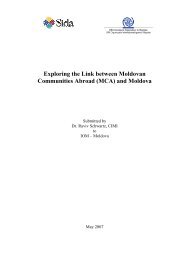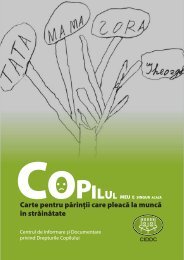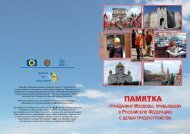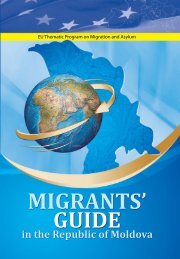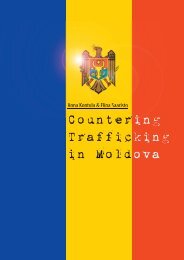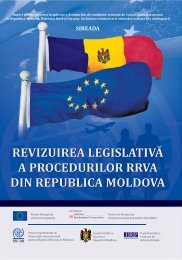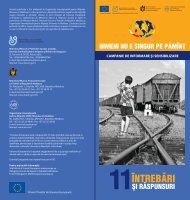Trafficking in Human Beings in Southeastern Europe - Iom
Trafficking in Human Beings in Southeastern Europe - Iom
Trafficking in Human Beings in Southeastern Europe - Iom
- No tags were found...
You also want an ePaper? Increase the reach of your titles
YUMPU automatically turns print PDFs into web optimized ePapers that Google loves.
<strong>Traffick<strong>in</strong>g</strong> <strong>in</strong> <strong>Human</strong> Be<strong>in</strong>gs<strong>in</strong> <strong>Southeastern</strong> <strong>Europe</strong>The traffick<strong>in</strong>g of children <strong>in</strong> Albania, both boys and girls, appears to be ma<strong>in</strong>lyfor the purposes of forced labour <strong>in</strong>clud<strong>in</strong>g begg<strong>in</strong>g, drug deal<strong>in</strong>g and activitiessuch as wash<strong>in</strong>g car w<strong>in</strong>dows. However, there have been some reports of childrenbe<strong>in</strong>g re-sold for prostitution. This is organised by networks of traffickerswho move the children <strong>in</strong>to Greece where there is a lucrative market for thisactivity. Newspaper articles also report children be<strong>in</strong>g used for organ donation,but this is unsubstantiated.AlbaniaThese children come from all over Albania but the ma<strong>in</strong> areas are Berate,Korce, Fier, Elbasan and Tirana. The children range <strong>in</strong> age from 0 to 15 years.There are reports from an Albanian NGO that girls as young as 12 years areoften re-trafficked <strong>in</strong>to prostitution from these begg<strong>in</strong>g r<strong>in</strong>gs, though there islimited <strong>in</strong>formation on this.Children generally come from impoverished and dysfunctional families. Typically,these children have either never attended school or have dropped out <strong>in</strong>order to work to support the family. These families are known to the traffickersand are groomed to permit their children to travel to Greece to work. Promisesof monetary remittances are made, but cease rapidly after a couple ofmonths.The majority of trafficked children come from the Roma m<strong>in</strong>ority <strong>in</strong> Albania,although there are also children of Albanian orig<strong>in</strong> and the problem cannot beseen as specific to one m<strong>in</strong>ority group. There are several categories of childrenwho leave Albania and stay abroad:• Those who leave with their parents who then abandon them;• Those sold by their parents to traffickers <strong>in</strong> Albania, <strong>in</strong> exchange fora promise of future <strong>in</strong>come;• Abandoned children who are taken abroad by traffickers;• Those who are sent by the family to earn money.Children are trafficked <strong>in</strong>to Greece either by foot across the mounta<strong>in</strong>s, <strong>in</strong> theback of a lorry or across the border with false documents and with false“mothers”. Aga<strong>in</strong>, it appears that the connivance of the authorities <strong>in</strong> bothGreece and Albania is an implicit part of the problem.In the country of dest<strong>in</strong>ation, children work on the streets, begg<strong>in</strong>g, wash<strong>in</strong>gcar w<strong>in</strong>dows and sell<strong>in</strong>g th<strong>in</strong>gs. Older children, over 12, are often <strong>in</strong>volved <strong>in</strong>illegal activities, and prostitution. There are no special provisions for the treatmentof underage illegal migrants <strong>in</strong> any of the countries of dest<strong>in</strong>ation, sothey are treated the same way as adults. They are arrested, deta<strong>in</strong>ed, andkept <strong>in</strong> detention centres together with traffickers and other adult illegalmigrants. While <strong>in</strong> detention they are often abused, mistreated and raped, bythe guards and other <strong>in</strong>mates. After a couple of days they are deported to theborder and left there. Younger children, under 12 years old, are placed <strong>in</strong>orphanages where they are forcibly nationalised and lose contact with theirnative language.In Greece the situation of children has recently changed. In 2000, an <strong>in</strong>ternationalNGO, Terre des Hommes (TdH) reported on the many children openlycarry<strong>in</strong>g out “illegal activities” on the streets of the ma<strong>in</strong> cities of Greece.Today, the Greek police have “cleaned” the streets of the ma<strong>in</strong> cities. Traffickershave responded by chang<strong>in</strong>g the routes and the characteristics of child traffick<strong>in</strong>ghave changed. Around 80 percent of the trafficked children that were <strong>in</strong>Greece have changed location and activities, and disappeared <strong>in</strong>to other networks,cities or countries. Accord<strong>in</strong>g to TdH, neither the police nor the state<strong>in</strong>stitutions nor NGOs <strong>in</strong> Greece know the whereabouts of the children.129



